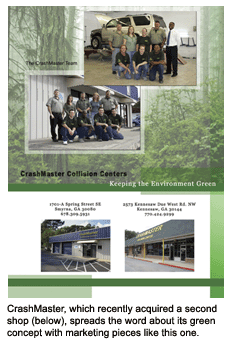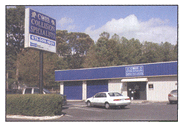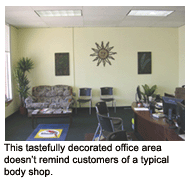With 2008 just around the corner, everyone is thinking green. The stereotype that environmentally conscious people are all tie-dyed clad, patchouli-reeking hippies has gone the way of the Summer of Love and Timothy Leary. Today, going green means respecting the health of others and the environment, as well as improving processes and reducing waste. And while it might cost more to implement, its value will be seen in the long run.
Keith B. Meisner Sr. and Richard F.S. Sargo have implemented the green concept in two full-line collision repair shops in Cobb County, Georgia: CrashMaster Collision Center in Kennesaw, which they acquired in March, and Cobb Collision Specialists in Smyrna, which became a CrashMaster in September. The new location has approximately 10,000 square feet with two frame bays, a semi-downdraft spraybooth, designated inspection and mechanical bays, compression resistance welding, plastic welding and repair, A/C, a laser measuring system and automotive diagnostic equipment.
 In Their Blood
In Their Blood
As third-generation body shop professionals, both Meisner and Sargo have seen the effects that their industry’s byproducts have had on their grandfathers and fathers. “My grandfather was doing bodywork and paint work when strapping a shirt across your face or wearing a paper mask was state of the art,” Meisner says. “And he died because of this industry.” Multiple strokes were attributed to paint exposure over the years, he says.
Sargo’s father recently underwent quadruple bypass surgery and has respiratory issues. “They told him his lungs looked like he’s been smoking for years,” he says. “He hasn’t smoked in 44 years.”
Family history played a role in going green, but it wasn’t the only motivator. When Meisner and Sargo visited what would become the first CrashMaster, they noticed that a day care center was right behind the shop and a Dairy Queen was next door. “You could smell the paint outside and knew there were solvents in the air,” Meisner says.
 After acquiring the shop, the owners decided they would extend green practices to every aspect of their business, keeping the children and diners nearby in mind. Meisner and Sargo joke that the cost of converting to a green shop was equal to the cost of funding seven children’s college educations.
After acquiring the shop, the owners decided they would extend green practices to every aspect of their business, keeping the children and diners nearby in mind. Meisner and Sargo joke that the cost of converting to a green shop was equal to the cost of funding seven children’s college educations.
Despite the financial outlay, they purchased the second location on the other side of the county six months later. The shop had wanted to go green, but didn’t have the means. That’s where Meisner and Sargo came in.
When they visited the site, it was déjÀ vu – the shop is next door to a day care center, and a Dairy Queen is across the street. And the shop’s workload and size were similar to those of Crash- Master. “It’s like a mirror image of our existing shop,” Meisner says.
Because the two shops are so similar, the owners were able to convert the newest shop into a green environment with fewer hiccups than the first time around. “We learned from our growing pains what we needed to do for the new location,” Sargo says. He and Meisner are currently calculating how much the second shop’s conversion to green cost, as well as their savings by using green products and processes instead of traditional ones. The owners plan to add a third green shop to the CrashMaster family.
Being Green
The solvent-based paint that Meisner and Sargo had once smelled has been replaced by water-based paint, and a computerized paint mixing system minimizes waste by mixing only the necessary amount of paint for a job. The no-VOC basecoat uses deionized water to reduce the paint, and then HVLP (high-volume, low-pressure) spray guns apply the paint efficiently.
“By using our water-based paint system, we’ve drastically reduced the amount of waste we produce,” Meisner notes. “We actually apply less material to the car and get better coverage than with a solvent-based system where you’re applying more material to the car and getting less coverage.” A filtration system captures the maximum amount of airborne particulates, and the shop reuses painters’ plastic sheeting.
By cutting waste and pollution, CrashMaster is also cutting costs. The owners have a better grasp of their waste, and they have a better grasp of their material costs. For example, a painter using solvent-based paint on a job produced one quart of waste. With waterborne paint, only one pint is wasted.
Used oil, antifreeze, refrigerant and waste paint are recycled, along with sheet metal, batteries and repairable plastics. CrashMaster has also implemented a paper and cardboard recycling program that’s available to the public. “Customers – and potential customers, hopefully – will come by and they’ll recycle newspapers, telephone books and cardboard,” Meisner says. “It’s just another thing that we can do to better the environment.”
The shop also runs every process as efficiently as possible; Meisner and Sargo spent two to three months coming up with standard operating procedures (SOPs) for each process. A parts cart SOP keeps materials off the floor and undamaged, and ensures employees receive and inventory parts correctly. CrashMaster waits until all necessary parts are on the cart before scheduling repairs or telling the customer when the car will be finished. The detailer also tests every mechanical and electrical part on a repaired car before returning it to the customer. These steps guarantee that a customer will return to the shop only once to pick up the repaired car.
SOPs necessitate that bodymen and painters use a VAC system when sanding so that dust doesn’t dirty cars, expediting the detailing process, which uses non-phosphate biodegradable soaps. The shop’s employees also check compressors regularly to ensure they don’t have costly leaks in the air hoses. Since the conversion, no employees have called in sick. Meisner and Sargo say that employees have a better disposition because of the shop environment, and they’re happier because they’re more efficient. Going green has removed both solvent-based fumes and frustrations from the air, the owners maintain.
From IT to TP
When it came to selecting an eco-friendly management system, many vendors claimed that their systems were paperless, but Meisner says they really weren’t. “We went through so many different management systems until we finally found one that worked the way we do,” he says. Sargo adds, “It was the only company that would work with us and make changes to benefit going green.”
 Their management system ensures accountability for each department, person, process and vendor, as well as for insurance companies, and it eliminates waste. “One of the biggest things we’ve cut down on is paper usage,” Sargo notes. With the electronic management system, employees can import scanned items, attachments, photos, voicemails and WAV files.
Their management system ensures accountability for each department, person, process and vendor, as well as for insurance companies, and it eliminates waste. “One of the biggest things we’ve cut down on is paper usage,” Sargo notes. With the electronic management system, employees can import scanned items, attachments, photos, voicemails and WAV files.
Paper invoices are scanned into CrashMaster’s management system, eliminating the need for multiple copies. Most of CrashMaster’s vendors communicate via fax, and some use e-mail, the choice medium. Both methods, though, cut down on paper use. “We don’t have to print off a copy to fax, we send it right through our server,” Meisner says. “Then we get a confirmation in our system showing that it was sent. It creates accountability.”
An electronic estimating system allows customers to receive estimates via fax or e-mail, the latter of which they can forward to others. (The customer still receives a paper copy for warranty purposes, and a signed copy of the repair order is still kept on file.)
In their offices, Meisner and Sargo use recycled products, including recycled paper, file folders, toner and ink. If a product is available in a re-cycled form, they’ll use it. This applies in the offices, workstations and even the restrooms. “The toilet paper’s actually recycled newspaper!” Sargo says.
The owners have found the toilet paper’s original function to be useful, as well. They paid to advertise in a local newspaper, in which they contribute an eco-friendly tip of the month, and they rely heavily on word of mouth for referrals.
Customers range from those who choose the shops because they’re eco-friendly to those who find the green aspect as a surprising concept or added benefit. Meisner, who has 15 years of experience as an adjuster and estimator, is currently developing an informational campaign comprising brochures with content targeted specifically at insurance companies. “It will let them know who we are and how we can help their customers be more satisfied in the repair process,” he says.
CrashMaster is on 11 DRPs, and Meisner and Sargo say that the insurance companies don’t dictate how to repair a car; they just ask Crash- Master to be a partner in making a smooth transition and an efficient process for the customer. While the owners are satisfied with their current DRPs, the informational campaign is not an attempt to get on more. “I don’t want to put all my eggs in one basket,” Meisner says. “I would rather partner with an insurance company to make the entire transition from damage to re-paired smoother, faster and more efficient, which in turn makes the customer and the insurance company happier.”
Insurance companies have noticed CrashMaster’s streamlined operations, which have resulted in lower repair costs and faster turnaround, lowering the rental car payout and making everyone happy. “The companies we deal with are also environmentally conscious,” Sargo notes.
Other collision repairers have noticed, as well. Meisner and Sargo are not the only ones in Cobb County with the welfare of others and the environment in mind. “We get phone calls every week from other body shops that would like us to come in and help them transform,” Sargo says.
Perhaps someday those shops will all be eco-friendly. Until then, they’ll have to live with being green – with envy.
Michael T. Peltier is managing editor of BodyShop Business.
|
CrashMaster Collision Center
Location: Smyrna, Georgia Established: 2007 (originally established as Cobb Collision Specialists in 1999) Square Footage: 10,000 Owner: Keith B. Meisner Sr. and Richard F.S. Sargo No. of Employees: 7 – 2 estimators, 1 administrator, 2 bodymen, 1 painter, 1 detailer Repair Volume/No. of Cars Per Month: 50-60 Average Repair Cost: $1,875 DRPs: 1 |
|
Behind the Bays
Estimating System: ADP Management System: Summit Prep Booth: 1 custom-built mobile prep station Spraybooth: 1 Garmat semi-downdraft booth Lift: 1 AMMCO 2-post lift Straightening System: 1 Chief EZ Liner Measuring/Dimensioning System: 1 Chief Velocity Welding Equipment: 1 Lincoln MIG welder, 1 Miller MIG welder and 1 Damien compression resistance welder Paint Mixing System: BASF/Glasurit Paint: 90-Line Waterborne Future Equipment Purchases: 1 Snap-On scissor lift, 1 Dataliner |













